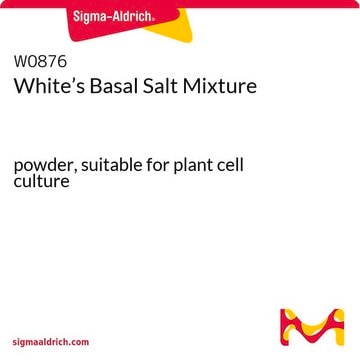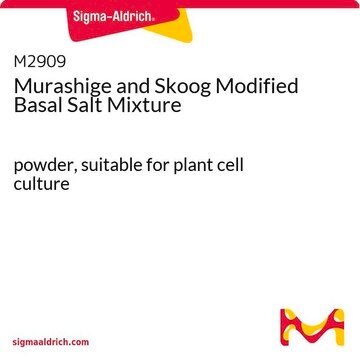The use of this product for hydroponic cultures has not been studied, so suitability cannot be confirmed. The 1L container contains 1.6 grams of powder, which is enough to make 1 liter of solution.
H2395
Hoagland′s No. 2 Basal Salt Mixture
powder, suitable for plant cell culture
Synonym(s):
Hoagland solution 2
Select a Size
Select a Size
About This Item
Recommended Products
form
powder
Quality Level
technique(s)
cell culture | plant: suitable
application(s)
agriculture
storage temp.
2-8°C
Application
- in the preparation of Hoagland′s solution for treating root tips[1]
- to grow maize (Zea mays L.) seeds[2]
- to grow rice seedlings[3] and to treat M. sinensis (cv. Kosung) seedlings hydroponically[4]
Formula variant
Quantity
related product
Signal Word
Danger
Hazard Statements
Precautionary Statements
Hazard Classifications
Acute Tox. 4 Oral - Eye Dam. 1 - Ox. Sol. 3
Storage Class Code
5.1B - Oxidizing hazardous materials
WGK
WGK 2
Flash Point(F)
Not applicable
Flash Point(C)
Not applicable
Regulatory Listings
Regulatory Listings are mainly provided for chemical products. Only limited information can be provided here for non-chemical products. No entry means none of the components are listed. It is the user’s obligation to ensure the safe and legal use of the product.
EU REACH SVHC Candidate List
EU REACH Annex XVII (Restriction List)
Choose from one of the most recent versions:
Certificates of Analysis (COA)
Don't see the Right Version?
If you require a particular version, you can look up a specific certificate by the Lot or Batch number.
Already Own This Product?
Find documentation for the products that you have recently purchased in the Document Library.
Customers Also Viewed
Articles
Classical plant tissue culture media developed years ago by pioneers such as Murashige, Skoog, Gamborg, and others still play a vital role in plant tissue culture research today.
-
Hello The Hoagland salt is for in vitro cell culture? I need it for hydroponic culture only. you think its suitable? and another question: 1 L means that its the weight of bottle? or it is just enough for making 1 liter soution of Hoagland?
1 answer-
Helpful?
-
-
Good day Do you have Hoagland's solution that supply all elements except Nitrogen?
1 answer-
Currently, this product is the only Hoagland's basal salt mixture available. This is a powdered medium that is prepared at 1.6 grams per liter. The formulation includes Calcium Nitrate. Please see the link below to review the formulation of this and other plant basal salt mixtures and media:
https://www.sigmaaldrich.com/deepweb/assets/sigmaaldrich/product/documents/137/040/h2395for.pdfHelpful?
-
-
Can the Hoagland's solution be autoclaved?
1 answer-
Yes, this product in solution can be autoclaved for sterilization. Please find the preparation instructions below.
This powder is extremely hygroscopic and must be protected from atmospheric moisture. Do not open the container until its contents are allowed to warm to room temperature. If possible the entire contents of the package should be used immediately after opening.
1.6 g of powder is required to prepare 1 L of medium.
Preparing this product in a concentrated form is not recommended as some salt complexes may precipitate. Supplements may be added prior to sterilization or added aseptically to a sterile medium. Certain supplements (i.e. heat labile) may require filter sterilization and may affect the shelf life of the medium.
The basic steps for preparing culture medium are the following:
1. Using a container twice the size of the desired final volume, measure out approximately 90% of the final required volume of tissue culture grade water (e.g. Sigma Product No. W-3500). Example: 900 ml for a final volume of 1000 ml.
2. While stirring, add the powdered product.
3. Rinse the original container with a small volume of tissue culture-grade water to remove traces of the powder. Add to the solution in Step 2.
4. Add any desired supplements (e.g. vitamins, gelling agent, auxin, cytokinin, etc.).
5. While stirring, adjust to the desired pH (e.g. 5.7 +/- 0.1) using KOH, NaOH, or HCl.
6. Add additional tissue culture-grade water to bring the medium to the final volume.
7. If a gelling agent is used, heat the solution to approximately 100°C while stirring.
8. Dispense the medium into culture vessels before or after autoclaving according to your application. Add heat labile constituents after autoclaving.
9. Sterilize the medium in a validated autoclave at 1 kg/cm2 (15 psi). The medium should attain a temperature of 121°C for at least 15 min.All media preparations should be stored at 0-5°C. Store dry powder in a desiccator. Deterioration of powdered medium may be recognized by the following: 1) color change; 2) granulation, clumping, or particulate matter throughout the powder; 3) pH change; and 4) inability to promote growth when properly used.
Helpful?
-
-
Why do we use ferric tartarte in this medium. Please specify the role of ferric tartarte. Can ferric tartarte be replaced with ferric sulphate or ferric citrate?
1 answer-
Ferric tartrate is used in the original Hoagland's classical medium formulation developed in the 1930s. This product is a duplication of that formulation. This compound serves as the source of iron in this specific formulation. The most common source of iron utilized in plant basal salt mixtures is Ferrous Sulfate Heptahydrate. Ferric Citrate is less commonly used, however it is present in several Lindemann Orchid salt mixtures. Other iron sources may be suitable, but these have not been evaluated in published classical media formulations.
Helpful?
-
-
Hello, I am in need of some Hoagland solution for my pots. I am in need of 20l of half strength Hoagland solution. Can you provide the technical details and how to use this solution ?
1 answer-
The 1L and 10L package sizes are indicative of the amount of basal salt solution that can be prepared from the powder within. The 1L package contains 1.6 grams and the 10L package contains 16 grams. To prepare at half strength, simply double the volume of water to be added. The 1L package can be diluted in 2L of water and the 10L package can be diluted in 2L of water. Stirring will be required.
Note that this powder is extremely hygroscopic and must be protected from atmospheric moisture. Allow the container to reach room temperature prior to opening.
Please see the link below for additional preparation instructions:
https://www.sigmaaldrich.com/US/en/technical-documents/protocol/cell-culture-and-cell-culture-analysis/plant-tissue-culture/media-preparationHelpful?
-
-
1.6g of powder makes 1L of solution - how many grams is in the 1L container of powder? I.e. how many litres can be made using the 1L of powder
1 answer-
The 1L and 10L package sizes are indicative of the amount of basal salt solution that can be prepared from the powder within. There is a sufficient amount of powder to prepare either 1 or 10 liters in each bottle, 1.6 grams and 16 grams, respectively. Note that this powder is extremely hygroscopic and must be protected from atmospheric moisture. Allow the container to reach room temperature prior to opening.
Helpful?
-
-
How many L of Hoagland Solution full strength can I prepare with 1.6 g of SKU H2395?
1 answer-
The classical Hoagland's No. 2 formulation shows 1.6 G of the basal salt mixture is sufficient to prepare 1L of medium, This product is a dry powder medium preweighed to prepare the volume stated - 1L and 10L.
Helpful?
-
-
is the hoagland's no. 2 basalt mixture powder 1 ltr, 1 ltr of powder or one ltr of solution or enough powder to make one liter of solution ?
1 answer-
For the SKU H2395-1L, the material is formulated to contain 1.6 grams of powder which is reconstituted to a final volume of 1L of medium.
Helpful?
-
Active Filters
Our team of scientists has experience in all areas of research including Life Science, Material Science, Chemical Synthesis, Chromatography, Analytical and many others.
Contact Technical Service
















